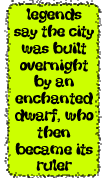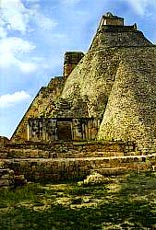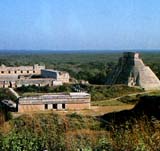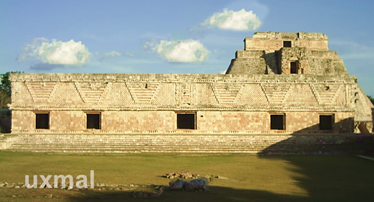
|
 |
|
The temple at the top section has a doorway in the form of a Chac mask. This pyramid is the tallest in Uxmal, but it is also known as the House of the Dwarf (Casa del Enano) because of an ancient legend stating that it was built overnight by an enchanted dwarf who then became the city's ruler. At the tourist entrance to the central area is the Pyramid of the Magician, (shown at right) The pyramid is 90 feet tall and built in three sections. Also on the terrace near the Governor's Palace, is the House of the Turtles, a smaller building taking its name from its wall sculptures of turtles. The Great Pyramid measures 260 feet on each side. |
 |
|
There are several Mayan tours available to take guests right to the entrance. |
|
| The House of the Pigeons, with a pigeonhole-style upper section and the South Temple. Other important places are the Cemetery Group, the House of the Old Woman (Casa de la Vieja), and the series of ruins called the North Group. | |
Uxmal is ancient city in the north Yucatán peninsula of Mexico. A Late Classic period MAYA center, Uxmal flourished between 600 and 900. The site has several fine examples of Mayan architecture, including the Nunnery, with elaborate stone mosaic friezes; the Governor's Palace, with some 20,000 carved stone elements and the Pyramid of the Magician. The Maya abandoned Uxmal shortly after 950.
Uxmal Pronounced “oosh-mawl,” Uxmal was one of the greatest Maya cities.
The city was built sometime during the 5th or 6th centuries but archaeological evidence suggests that the area had been inhabited as a farming center since as far back as 800 B.C.
The city shows has the architectural styles called the Maya “Puuc” style.
The grandest structure of the site is the Pyramid of the Magician. Though not a true pyramid (it is elliptical, not square), the pyramid stands 38 meters tall with a staircase at a steep angle.
The Nunnery is thought to have been a school of some sort, either for the military or the children of the elite classes. Southwest of the pyramid, is the Governor’s Palace, the largest and fanciest structure in Uxmal. The intricate stonework and the 320 foot long mosaic facade of the palace make the building the most beautiful of Uxmal. The Palace’s main door was placed in perfect alignment with Venus. Another large structure on the site is the Great Pyramid.At 90 feet tall, this nine-level pyramid is a largest structure of Uxmal. It is decorated with fancy carvings of masks, birds, and flowers. Like many of the other ruins in Mexico, Uxmal has a restored ball court.
There are huge cisterns which supplied the city with water. To collect water, the city built huge cisterns to capture rain.
That's why the rain god, Chaac, was the most worshipped in Uxmal.Uxmal is one of the most well known of the Maya cities, and rated by many archaeologists as the finest. There is also a small museum and auditorium. There’s an admission fee of around $4 and a further fee for the sound and light show. All the sites are free on Sundays
From Mérida, follow the 261 in the direction of Campeche. The site is about 70 miles from Mérida and it should take about an hour by car. Background -- The name Uxmal means 'thrice-built' in Mayan, referring to the construction of its highest structure, the Pyramid of the Magician.The Maya would often build a new temple over an existing one, and in this case five stages of construction have actually been found.
Uxmal was one of the largest cities of the Yucatán peninsula, and at its height was home to about 25,000 Maya. Like the other Puuc sites, it flourished in the Late Classic period (around 600-900 AD). Scientists think its rulers were also in charge of nearby settlements in Kabah, Labná and Sayil, and there are several sacbeob connecting the sites.
With a population of about 25,000 Uxmal was one of the largest cities in the Yucatán .What makes Puuc buildings different? Puuc architecture has several predominant features, most notably constructions with a plain lower section and a richly decorated upper section.
Carvings most commonly found include serpents, lattice work and masks of the god Chac.
Chac was the god of rain, greatly revered by the Maya at Uxmal because of the lack of natural water supplies in the city. Although the Yucatán has no surface rivers, most Maya cities, including Chichén Itzá, used cenotes to access underground water, however there were no cenotes at Uxmal. They had to collect water in cisterns, built in the ground.Human Sacrifice were probably performed at the highest temple of the House of the Magician. The Legend of the Pyramid of the Magician Legend held that when a certain gong was sounded, the town of Uxmal would fall to a boy "not born of woman".
One day, a dwarf boy, who had been raised from an egg by a witch, sounded the gong and struck fear into the ruler, who ordered him to be executed. The ruler promised that the boy’s life would be saved if he could perform three impossible tasks, one of which was to build a giant pyramid in a single nightThe boy achieved all the tasks, and became the new ruler.
The Pyramid of the Magician is 117 feet high . This pyramid is the combination of five temples.This collection of four buildings around a quadrangle was named "Casa de las Monjas" (The Nunnery) by the Spanish, because the 74 small rooms around the courtyard reminded them of nuns’ quarters in a Spanish convent.
The Palace of the Governor -- Regarded by many experts as the best example of Puuc architecture in existence, the Palace of the Governor stands on an raised platform and is thought to be one of the last constructed building on the site (around 980 AD). The structure has a typical plain lower section and a richly carved upper. Carvings include serpents, lattices and masks and a central seated god-like figure with a long plumed head- dress.
House of the Turtles -- Next to the Palace of the Governor and on the same raised platform stands the House of the Turtles. Turtles were carved around the cornice. It was believed that turtles suffered with man at times of drought and would also pray to Chac for rain.The Great Pyramid -- Originally nine levels high, the Great Pyramid has been partially restored. It seems that another temple was to be built over the existing structure and some demolition had taken place before the plans were halted, leaving the pyramid in bad condition.







